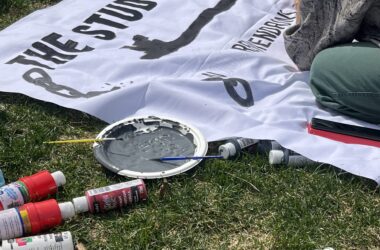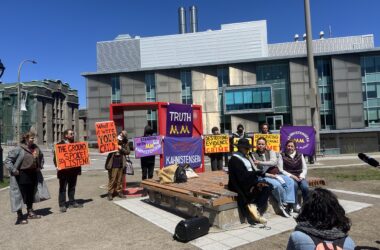Amid the many varied accounts of Nov. 10 offered by occupiers and administrators over the past two weeks, many have forgotten past successful, peaceful occupations. The events of April 2, 1997 juxtapose this month’s occupation, and offer a shining example of a peaceful student protest done correctly.
Beginning on a Wednesday morning, and through the next two days and two nights, 18 McGill students successfully and peacefully occupied the office of then-Principal Bernard Shapiro. The 1997 occupation, much like its more recent counterpart, aimed to address tuition increases (a new administrative fee had just been instituted), as well as to improve student representation in decision-making.
The Tribune sat down with Mike Toye, Claude Theoret, and Sam McGavin, three former student activists and organizers of the 1997 demonstration, to hear their views on the contrast between the Nov. 10 occupation and their own.
Toye spoke about the approach his group used to enter the James Administration Building.
“We didn’t want to give the administration an excuse to act badly, so we were all … respectful, play-by-the rules … a bit over the top,” Toye said. “When we went in, we already had forms printed up, which were waivers basically, explaining the situation, asking the staff that were there to leave and asking them to sign this form saying they chose to stay.”
Prior to the demonstration, occupiers had undergone training in passive resistance.
“We had trained a [number] of people to be our occupiers,” Theoret said. “We had a lot of education to do before we had people who could actually function in those kinds of situations.”
“I think there was a certain level of bewilderment,” Toye said of the administration’s reaction. “One is that they weren’t prepared and didn’t know how to react. I don’t know if security or the administration has a plan for occupations … but that might have influenced how quickly security was called this time on Nov. 10. We were pretty calm—a larger group—and no one had any face covers. We weren’t confrontational at all and tried to focus on the reasons we were there rather than giving the staff any concern about their personal safety.”
The occupiers spent well over 48 hours inside Shapiro’s office. Their occupation was one of almost 10 across Canada that year, and received considerable media attention. By the following Friday morning, the last of the occupiers planned to leave according to a preset schedule, exiting in small groups to conceal how many were left inside. Their list of demands, including an open meeting between SSMU and PGSS representatives and senior administrators, had not been met, but they felt that the media attention surrounding their occupation adequately spread their message.
The underfunding of universities was equally an issue back then, especially as it came after the Martin-era transfer cuts to the provinces.
“The university was on the record quite publicly as advocating for deregulation of tuition fees and significant increases, and they were trying to find all sorts of loopholes for charging students more,” Toye said. “Our position was that they should be advocating just as hard for appropriate public policy and taxation and other mechanisms for government to provide the required funding.”
“We saw really the beginning of a trend which seems to have only worsened … at the time it was trying to maintain the status quo,” McGavin said. “Since then there’s just been this massive rollback in terms of accessibility.”
“The student representation issue was seen as a way to influence decision making and the positions of McGill on a longer term basis,” Toye added.
“[Today], the Charest government points to other provinces and says ‘look how high the fees are there,'” McGavin said. “I think [student activism] is really the determining factor in Quebec as to whether or not education [remains] as accessible as it currently is.”
Toye also spoke on the validity of occupation as a form of student protest.
“An occupation is a tactic that people resort to when they feel they aren’t being heard. If we felt that the positions … student groups were putting forward were just being ignored, then we’re going to find other ways to make ourselves heard,” Toye said. “If the administration wants to avoid things like occupations and other actions that go beyond dialogue in the future, they need to make sure they are actually having a meaningful and constructive dialogue with students first.”
“The occupation was the most educational experience I had in my years at McGill … it had been 10 years since the previous occupation—and now it’s been 14, and I feel it’s a bit of a shame that the occupation course only gets run once a decade,” he said. “Because [you learn] everything from politics and negotiation, public policy, consensus decision making, [to] ordering pizzas from a fifth floor. It’s a really intense and very valuable educational experience.”







